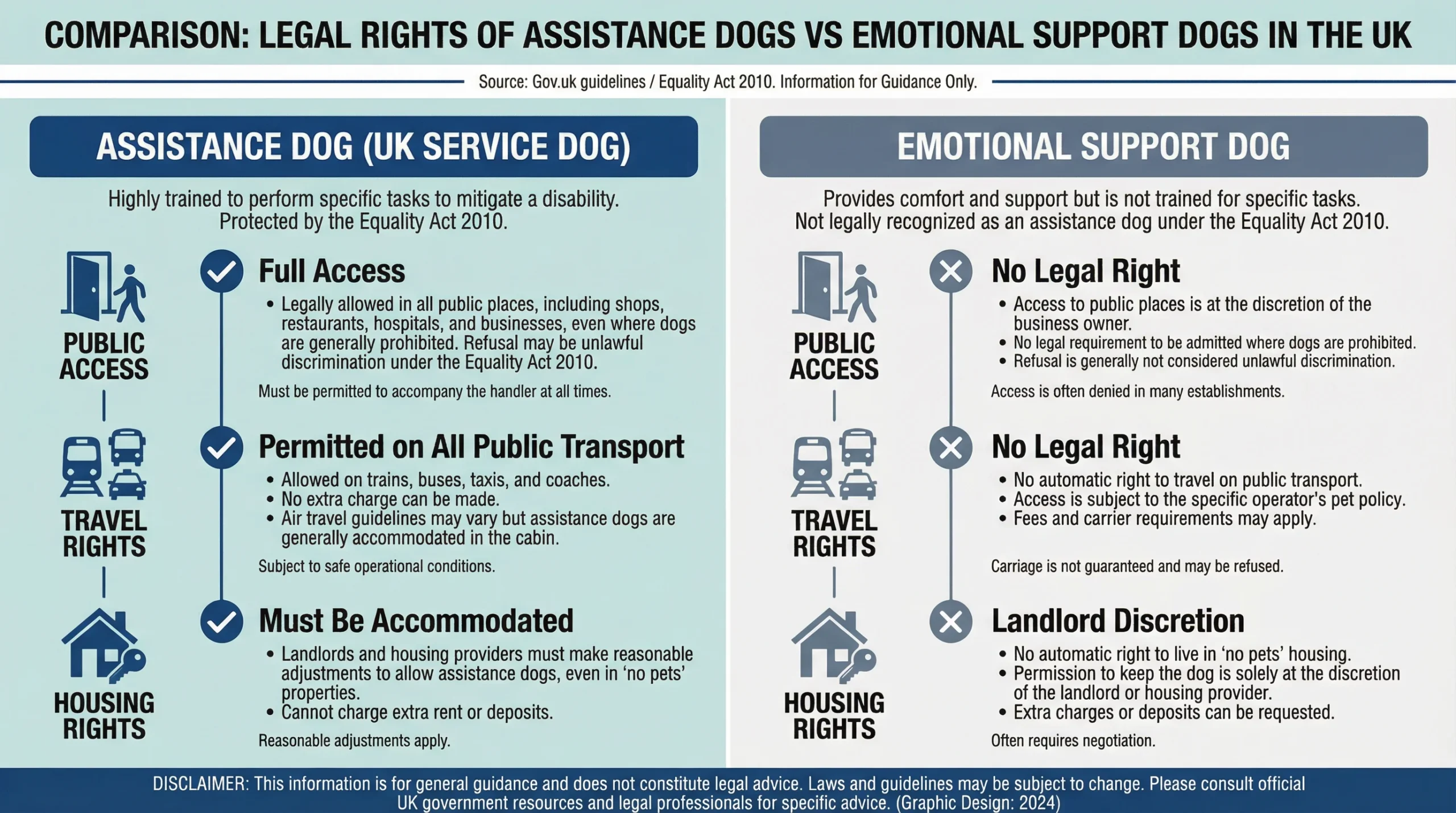Service Dog vs Emotional Support Dog in the UK is a topic that is often misunderstood, especially when it comes to legal rights and where each type of dog is allowed to go. While both provide life-changing support, their legal recognition and access rights are not the same. Knowing where each stands helps ensure the right kind of assistance is provided to the people who rely on them.
Many people confuse support animals, thinking any dog that helps emotionally must be a service animal, but that’s not the case in UK law.
Quick Answer
In the UK, only assistance dogs are legally protected under the Equality Act 2010. They must be trained to perform specific tasks for a person with a disability. Emotional support dogs offer valuable comfort and mental well-being benefits, but they are not recognised in law and therefore do not have automatic public access rights.
If a dog is not task-trained to support a person with a disability, it is not considered a service dog in the UK.
For broader guidance on responsible ownership, our UK dog care articles on FlexK9 provide helpful tips for everyday wellbeing.
What the UK Legally Recognises as a Service Dog
The correct term in the UK for a legally recognised service dog is an assistance dog. These dogs help individuals manage disabilities such as sight loss, mobility issues or certain mental health conditions.
To be recognised as an assistance dog, the dog must:
- Support a disability that has been formally diagnosed
- Be trained to perform specific tasks that reduce the impact of that disability
- Be safe and well-behaved in public environments
- Meet high health and welfare standards
UK-based charities like Guide Dogs and Dogs for Good are members of Assistance Dogs UK (ADUK), whose training standards are widely accepted by government bodies and businesses. The Equality and Human Rights Commission (EHRC) clearly states that assistance dogs are treated as “auxiliary aids” under the Equality Act 2010, and cannot be refused access where the public is allowed.
Training is the key factor that the law cares about. Not badges. Not vests.
Service Dog vs Emotional Support Dog in the UK
Emotional support dogs help people feel calmer, safer or less anxious. They make a huge difference to many lives, particularly for people with ongoing mental health struggles such as PTSD or anxiety disorders.
However:
- They are not defined in UK legislation
- They are not recognised as assistance animals
- They do not automatically gain the right to enter public places or transport
- Landlords and airlines can decline them entirely at their discretion
Websites selling emotional support dog “certificates” or “registrations” may appear convincing, but none are legally valid in the UK. These dogs are sometimes referred to as emotional support animals or therapy dogs, but these terms do not grant any legal access rights.
Comfort is valuable, but legally speaking, comfort alone is not enough.
Legal Rights: A Clear Comparison
| Topic | Assistance Dog (Service Dog) | Emotional Support Dog |
|---|---|---|
| Legal recognition | Equality Act 2010 | Not recognised |
| Public access | Allowed anywhere the public can go | Only allowed where pets are permitted |
| Transport | Must be accepted on buses, trains and taxis | Discretionary |
| Air travel | Permitted with documentation | Usually refused or charged |
| Housing rules | Landlords must consider reasonable adjustments | Landlord |

Housing and Tenancy Rights
People who rely on an assistance dog are protected from discrimination under the Equality Act 2010. This means landlords and letting agents must consider reasonable adjustments to allow a trained assistance dog in properties with a “no pets” rule. According to Assistance Dogs UK, landlords and housing providers must make reasonable adjustments for tenants with a trained assistance dog, overriding “no-pets” clauses under UK law.
Emotional support dogs are treated as pets. A landlord can refuse them even if they help with anxiety or well-being.
This is often an emotional and difficult difference, but it is the legal reality today. For a deeper look at public access and handler rights, see our full guide on UK service dog laws.
Public Transport and Travel Access
Assistance dogs have a legal right to travel on:
- UK rail services
- Buses and trams
- Licensed taxis and private hire vehicles
Transport staff are required to allow them and offer appropriate support when necessary. The dog must be calm, controlled and trained to behave safely in busy environments.
Airlines will usually permit an assistance dog to fly in the cabin when advance notice and documentation are provided. Emotional support dogs are almost always declined or treated as standard pets with fees. Public safety rules still apply, and our guide on the Dangerous Dogs Act 1991 explains the laws that affect dog behaviour in public environments.
The Equality Act 2010 extends to taxis, private hire and public transport; refusal to carry a disabled passenger with an assistance dog may amount to unlawful discrimination.
How a Dog Qualifies as a Service Animal in the UK
There are two main routes:
- Training through an ADUK member charity (most common)
- Owner-trained dogs, provided that training evidence can be demonstrated

Evidence may include:
- Medical confirmation of the disability
- Detailed records of training tasks the dog performs
- Behaviour assessments
- Veterinary care and vaccination records
There is no official ID card or government registry. Training and behaviour standards are what determine legitimacy.
Summary
Assistance dogs and emotional support dogs both play incredibly valuable roles. One provides trained disability support; the other offers emotional comfort. But UK law treats them very differently.
If you require your dog to accompany you in public places, on transport or in “no pets” housing, task-based training is essential. Without it, the dog will be treated as a companion animal, not an assistance dog.
Frequently Asked Questions
Are emotional support dogs allowed in shops or restaurants in the UK?
No. Only trained assistance dogs have public access rights.
For more clarity on where dogs can legally be taken on walks and in public spaces, see our dog leash laws guide.
Is anxiety classed as a disability in the UK?
Yes, if medically assessed. However, the dog must perform specific trained tasks beyond providing comfort.
Do assistance dogs need to wear a harness or vest?
It is not legally required, but visible identification helps prevent challenges in public spaces.
Can landlords refuse an emotional support dog?
Yes. Emotional support dogs are not protected under the Equality Act.
What is the difference between service dog and emotional support?
A service dog is trained to perform specific tasks for a person with a disability, while an emotional support dog provides comfort and companionship but is not trained for specific tasks. Service dogs have legal access rights under the Equality Act, whereas emotional support dogs do not have the same legal protections in public spaces.
Is an emotional support dog classed as a service dog?
An emotional support dog is not classified as a service dog.

